PTK2 protein tyrosine kinase 2 (PTK2), also known as focal adhesion kinase (FAK), is a protein that, in humans, is encoded by the PTK2 gene.[4] PTK2 is a focal adhesion-associated protein kinase involved in cellular adhesion (how cells stick to each other and their surroundings) and spreading processes (how cells move around).[5] It has been shown that when FAK was blocked, breast cancer cells became less metastatic due to decreased mobility.[6]
Function
The PTK2 gene encodes a cytosolic protein tyrosine kinase that is found concentrated in the focal adhesions that form among cells attaching to extracellular matrix constituents. The encoded protein is a member of the FAK subfamily of protein tyrosine kinases that included PYK2, but lacks significant sequence similarity to kinases from other subfamilies. It also includes a large FERM domain.[7][8]
With the exception of certain types of blood cells, most cells express FAK. FAK tyrosine kinase activity can be activated, which plays a key important early step in cell migration. FAK activity elicits intracellular signal transduction pathways that promote the turn-over of cell contacts with the extracellular matrix, promoting cell migration. FAK is required during development, with loss of FAK resulting in lethality. It seems to be a paradox that FAK is not absolutely required for cell migration, and may play other roles in the cell, including the regulation of the tumor suppressor p53. At least four transcript variants encoding four different isoforms have been found for this gene, but the full-length natures of only two of them have been determined.[9]
FAK is a protein of 125 kD recruited as a participant in focal adhesion dynamics between cells, and has a role in motility and cell survival. FAK is a highly conserved, non-receptor tyrosine kinase originally identified as a substrate for the oncogene protein tyrosine kinase v-src.[10] This cytosolic kinase has been implicated in diverse cellular roles including cell locomotion, mitogen response and cell survival. FAK is typically located at structures known as focal adhesions, which are multi-protein structures that link the extracellular matrix (ECM) to the cytoplasmic cytoskeleton. Additional components of focal adhesions include actin, filamin, vinculin, talin, paxillin, tensin[11] and RSU-1.
Regulation
FAK is phosphorylated in response to integrin engagement, growth factor stimulation, and the action of mitogenic neuropeptides.[12][13] Integrin receptors are heterodimeric transmembrane glycoproteins that cluster upon ECM engagement, leading to FAK phosphorylation and recruitment to focal adhesions.[14][15] FAK activity can also be attenuated by expression of its endogenous inhibitor known as FAK-related nonkinase (FRNK). This is a truncated protein consisting of only the carboxyl-terminal noncatalytic domain of FAK.[16]
Role in apoptosis
During early apoptotic signaling in human endothelial cells, FAK is cleaved by caspase 3 at Asp-772, generating two FAK fragments of approximately 90 and 130 kDa in length.[17] The smaller FAK fragment is termed "killer FAT" and becomes the domain associated with death signaling.[17] Throughout apoptosis, FAK is an important contributor to cell rounding, loss of focal contacts and apoptotic membrane formations such as blebbing,[18] which involves contracting the cortical actin ring and is followed by chromatin condensation and nuclear fragmentation.[19] Overexpression of FAK leads to inhibition of apoptosis and an increase in the prevalence of metastatic tumors.[18]
Structure
Focal adhesion kinase has four defined regions, or tertiary structure domains. Two of these domains, the N-terminal FERM domain and the Kinase domain form an auto-inhibitory interaction. This interaction—thought to be the result of hydrophobic interactions between the two domains[20]—prevents the activation of the Kinase domain, thereby preventing the signalling function of FAK. Release of this auto-inhibitory interaction has been shown to occur within focal adhesions—but not in the cytoplasm—and therefore is thought to require interaction with focal adhesion proteins, potentially as a result of mechanical forces transmitted through the focal adhesion.
C-terminus
A carboxy-terminal region of one hundred and fifty-nine amino acids, the focal adhesion targeting domain (FAT), has been shown to be responsible for targeting FAK to focal adhesions.[21] This domain is composed of four alpha helices arranged in a bundle. The N-terminal helix contains a phosphorylatable tyrosine (Y925) implicated in signal transduction. Two hydrophobic patches between helices—one formed by the first and fourth helix, the other formed by the second and third helix—have been shown to bind short helical domains of Paxillin.[22]
N-terminus
The function of the amino-terminal domain is less clear, but it has been shown to interact with the beta-1 integrin subunit in vitro and is thought to be involved in the transduction of signals from ECM-integrin clusters.[23] However, a study has called into question the importance of this interaction and suggested that interaction with the cytoplasmic region of the beta-3 integrin subunit is important.[24]
The amino-terminal domains of FAK share a significant sequence similarity with the band 4.1 domain first identified in erythrocytes. This 4.1 band domain binds to the cytoplasmic region of transmembrane proteins including glycophorin C, actin and spectrin.[25] This suggests that the amino-terminal region of FAK may have a role in anchoring the cytoskeleton, the exact nature of this role has not been clarified as yet.
Catalytic/regulatory domain
Between the amino and the carboxy regions lies the catalytic domain. Phosphorylation of the activation loop within this kinase domain is important for the kinase activity of FAK.[26]
Clinical significance
FAK mRNA levels are elevated in ~37% of serous ovarian tumors and ~26% of invasive breast cancers, and in several other malignancies.[27]
As a drug target
FAK inhibitors
Because of the involvement of FAK in many cancers, drugs that inhibit FAK are being sought and evaluated,[28] e.g. in 2012: PF-573,228 (PF-228), PF-562,271 (PF-271), NVP-226, Y15 (1,2,4,5-benzenetetraamine tetrahydrochloride), and PND-1186,[28]
By 2013 GSK2256098 and PF-573,228 had completed at least one phase 1 trial.[28]
Additional FAK inhibitors in clinical trials in 2014 were:[27] VS-6062 (PF 562,271), VS-6063 (PF-04554878 defactinib) and VS-4718 (PND-1186) (all three are ATP-competitive kinase inhibitors). VS-6063 was in a phase II trial in patients with KRAS mutant non-small cell lung cancer (Trial ID: NCT01951690) to see how the response depends on tumor-associated INK4a/Arf and p53 mutations.[27]
In 2015, a mesothelioma trial of VS-6063 was ended early due to 'poor performance'.[29]
Interactions
PTK2 has been shown to interact with:
- BCAR1,[30][31][32][33][34][35]
- BMX,[36]
- CD61,[37][38]
- CRK,[31][39]
- DCC,[40]
- FYN,[41][42]
- GIT1,[43][44][45]
- GRB7,[46]
- Grb2,[32][39][41][47][48]
- IRS1,[49]
- ITGB5,[37]
- JAK2,[50][51]
- MAPK8IP3,[52]
- NCK1,[53][54]
- NCK2,[54]
- NEDD9,[55]
- NEO1,[40]
- P53,[56]
- PIK3R1,[57]
- PTEN,[58][59]
- PXN,[35][60][61][62][63]
[64][65][66][67][68] - RB1CC1,[69]
- STAT1,[70]
- Src,[31][39][41][49][71][72]
- Syk,[38][73]
- TGFB1I1,[61][74][75]
- TLN1,[60][76]
- TSC2,[77]
- YAP1.[78]
See also
References
- 1 2 3 GRCm38: Ensembl release 89: ENSMUSG00000022607 - Ensembl, May 2017
- ↑ "Human PubMed Reference:". National Center for Biotechnology Information, U.S. National Library of Medicine.
- ↑ "Mouse PubMed Reference:". National Center for Biotechnology Information, U.S. National Library of Medicine.
- ↑ André E, Becker-André M (January 1993). "Expression of an N-terminally truncated form of human focal adhesion kinase in brain". Biochemical and Biophysical Research Communications. 190 (1): 140–7. doi:10.1006/bbrc.1993.1022. PMID 8422239.
- ↑ Blackshaw SE, Dow JK, Lackie JM (1999). The dictionary of cell and molecular biology (3rd ed.). San Diego: Academic Press. ISBN 978-0-12-432565-4.
- ↑ Chan KT, Cortesio CL, Huttenlocher A (2009). "FAK alters invadopodia and focal adhesion composition and dynamics to regulate breast cancer invasion". The Journal of Cell Biology. 185 (2): 357–70. doi:10.1083/jcb.200809110. PMC 2700377. PMID 19364917.
- ↑ SCOPe: Structural Classification of Proteins — extended. Release 2.06. Lineage for Protein: Focal adhesion kinase 1
- ↑ Q00944
- ↑ "Entrez Gene: PTK2 PTK2 protein tyrosine kinase 2".
- ↑ Guan JL, Shalloway D (August 1992). "Regulation of focal adhesion-associated protein tyrosine kinase by both cellular adhesion and oncogenic transformation". Nature. 358 (6388): 690–2. Bibcode:1992Natur.358..690G. doi:10.1038/358690a0. PMID 1379699. S2CID 4328507.
- ↑ Chrzanowska-Wodnicka M, Burridge K (June 1996). "Rho-stimulated contractility drives the formation of stress fibers and focal adhesions". The Journal of Cell Biology. 133 (6): 1403–15. doi:10.1083/jcb.133.6.1403. PMC 2120895. PMID 8682874.
- ↑ Abedi H, Zachary I (June 1997). "Vascular endothelial growth factor stimulates tyrosine phosphorylation and recruitment to new focal adhesions of focal adhesion kinase and paxillin in endothelial cells". The Journal of Biological Chemistry. 272 (24): 15442–51. doi:10.1074/jbc.272.24.15442. PMID 9182576.
- ↑ Zachary I, Rozengurt E (December 1992). "Focal adhesion kinase (p125FAK): a point of convergence in the action of neuropeptides, integrins, and oncogenes". Cell. 71 (6): 891–4. doi:10.1016/0092-8674(92)90385-P. PMID 1458538. S2CID 37622498.
- ↑ Burridge K, Fath K, Kelly T, Nuckolls G, Turner C (1988). "Focal adhesions: transmembrane junctions between the extracellular matrix and the cytoskeleton". Annual Review of Cell Biology. 4: 487–525. doi:10.1146/annurev.cb.04.110188.002415. PMID 3058164.
- ↑ Burridge K, Turner CE, Romer LH (November 1992). "Tyrosine phosphorylation of paxillin and pp125FAK accompanies cell adhesion to extracellular matrix: a role in cytoskeletal assembly". The Journal of Cell Biology. 119 (4): 893–903. doi:10.1083/jcb.119.4.893. PMC 2289706. PMID 1385444.
- ↑ Taylor JM, Mack CP, Nolan K, Regan CP, Owens GK, Parsons JT (March 2001). "Selective expression of an endogenous inhibitor of FAK regulates proliferation and migration of vascular smooth muscle cells". Molecular and Cellular Biology. 21 (5): 1565–72. doi:10.1128/MCB.21.5.1565-1572.2001. PMC 86702. PMID 11238893.
- 1 2 Schlaepfer DD, Broome MA, Hunter T (March 1997). "Fibronectin-stimulated signaling from a focal adhesion kinase-c-Src complex: involvement of the Grb2, p130cas, and Nck adaptor proteins". Molecular and Cellular Biology. 17 (3): 1702–13. doi:10.1128/mcb.17.3.1702. PMC 231895. PMID 9032297.
- 1 2 Mehlen P, Puisieux A (June 2006). "Metastasis: a question of life or death". Nature Reviews. Cancer. 6 (6): 449–58. doi:10.1038/nrc1886. PMID 16723991. S2CID 11945472.
- ↑ Ndozangue-Touriguine O, Hamelin J, Bréard J (July 2008). "Cytoskeleton and apoptosis". Biochemical Pharmacology. 76 (1): 11–8. doi:10.1016/j.bcp.2008.03.016. PMID 18462707.
- ↑ Lietha D, Cai X, Ceccarelli DF, Li Y, Schaller MD, Eck MJ (June 2007). "Structural basis for the autoinhibition of focal adhesion kinase". Cell. 129 (6): 1177–87. doi:10.1016/j.cell.2007.05.041. PMC 2077847. PMID 17574028.
- ↑ Hildebrand JD, Schaller MD, Parsons JT (November 1993). "Identification of sequences required for the efficient localization of the focal adhesion kinase, pp125FAK, to cellular focal adhesions". The Journal of Cell Biology. 123 (4): 993–1005. doi:10.1083/jcb.123.4.993. PMC 2200138. PMID 8227154.
- ↑ Hildebrand JD, Schaller MD, Parsons JT (June 1995). "Paxillin, a tyrosine phosphorylated focal adhesion-associated protein binds to the carboxyl terminal domain of focal adhesion kinase". Molecular Biology of the Cell. 6 (6): 637–47. doi:10.1091/mbc.6.6.637. PMC 301225. PMID 7579684.
- ↑ Schaller MD, Otey CA, Hildebrand JD, Parsons JT (September 1995). "Focal adhesion kinase and paxillin bind to peptides mimicking beta integrin cytoplasmic domains". The Journal of Cell Biology. 130 (5): 1181–7. doi:10.1083/jcb.130.5.1181. PMC 2120552. PMID 7657702.
- ↑ Tahiliani PD, Singh L, Auer KL, LaFlamme SE (March 1997). "The role of conserved amino acid motifs within the integrin beta3 cytoplasmic domain in triggering focal adhesion kinase phosphorylation". The Journal of Biological Chemistry. 272 (12): 7892–8. doi:10.1074/jbc.272.12.7892. PMID 9065456.
- ↑ Girault JA, Labesse G, Mornon JP, Callebaut I (December 1998). "Janus kinases and focal adhesion kinases play in the 4.1 band: a superfamily of band 4.1 domains important for cell structure and signal transduction". Molecular Medicine. 4 (12): 751–69. doi:10.1007/BF03401769. PMC 2230389. PMID 9990861.
- ↑ Calalb MB, Polte TR, Hanks SK (February 1995). "Tyrosine phosphorylation of focal adhesion kinase at sites in the catalytic domain regulates kinase activity: a role for Src family kinases". Molecular and Cellular Biology. 15 (2): 954–63. doi:10.1128/MCB.15.2.954. PMC 231984. PMID 7529876.
- 1 2 3 Sulzmaier FJ, Jean C, Schlaepfer DD (September 2014). "FAK in cancer: mechanistic findings and clinical applications". Nature Reviews. Cancer. 14 (9): 598–610. doi:10.1038/nrc3792. PMC 4365862. PMID 25098269.
- 1 2 3 Dunn KB, Heffler M, Golubovskaya VM (December 2010). "Evolving therapies and FAK inhibitors for the treatment of cancer". Anti-Cancer Agents in Medicinal Chemistry. 10 (10): 722–34. doi:10.2174/187152010794728657. PMC 3274818. PMID 21291406.
- ↑ Researchers Stop Once-Promising Mesothelioma Clinical Trial. Oct 2015
- ↑ Salgia R, Pisick E, Sattler M, Li JL, Uemura N, Wong WK, Burky SA, Hirai H, Chen LB, Griffin JD (October 1996). "p130CAS forms a signaling complex with the adapter protein CRKL in hematopoietic cells transformed by the BCR/ABL oncogene". The Journal of Biological Chemistry. 271 (41): 25198–203. doi:10.1074/jbc.271.41.25198. PMID 8810278.
- 1 2 3 Hsia DA, Mitra SK, Hauck CR, Streblow DN, Nelson JA, Ilic D, Huang S, Li E, Nemerow GR, Leng J, Spencer KS, Cheresh DA, Schlaepfer DD (March 2003). "Differential regulation of cell motility and invasion by FAK". The Journal of Cell Biology. 160 (5): 753–67. doi:10.1083/jcb.200212114. PMC 2173366. PMID 12615911.
- 1 2 Hildebrand JD, Taylor JM, Parsons JT (June 1996). "An SH3 domain-containing GTPase-activating protein for Rho and Cdc42 associates with focal adhesion kinase". Molecular and Cellular Biology. 16 (6): 3169–78. doi:10.1128/MCB.16.6.3169. PMC 231310. PMID 8649427.
- ↑ Chellaiah MA, Biswas RS, Yuen D, Alvarez UM, Hruska KA (December 2001). "Phosphatidylinositol 3,4,5-trisphosphate directs association of Src homology 2-containing signaling proteins with gelsolin". The Journal of Biological Chemistry. 276 (50): 47434–44. doi:10.1074/jbc.M107494200. PMID 11577104.
- ↑ Okabe S, Fukuda S, Broxmeyer HE (July 2002). "Activation of Wiskott-Aldrich syndrome protein and its association with other proteins by stromal cell-derived factor-1alpha is associated with cell migration in a T-lymphocyte line". Experimental Hematology. 30 (7): 761–6. doi:10.1016/s0301-472x(02)00823-8. PMID 12135674.
- 1 2 Wang JF, Park IW, Groopman JE (April 2000). "Stromal cell-derived factor-1alpha stimulates tyrosine phosphorylation of multiple focal adhesion proteins and induces migration of hematopoietic progenitor cells: roles of phosphoinositide-3 kinase and protein kinase C". Blood. 95 (8): 2505–13. doi:10.1182/blood.V95.8.2505. PMID 10753828.
- ↑ Chen R, Kim O, Li M, Xiong X, Guan JL, Kung HJ, Chen H, Shimizu Y, Qiu Y (May 2001). "Regulation of the PH-domain-containing tyrosine kinase Etk by focal adhesion kinase through the FERM domain". Nature Cell Biology. 3 (5): 439–44. doi:10.1038/35074500. PMID 11331870. S2CID 23449101.
- 1 2 Eliceiri BP, Puente XS, Hood JD, Stupack DG, Schlaepfer DD, Huang XZ, Sheppard D, Cheresh DA (April 2002). "Src-mediated coupling of focal adhesion kinase to integrin alpha(v)beta5 in vascular endothelial growth factor signaling". The Journal of Cell Biology. 157 (1): 149–60. doi:10.1083/jcb.200109079. PMC 2173263. PMID 11927607.
- 1 2 Chung J, Gao AG, Frazier WA (June 1997). "Thrombspondin acts via integrin-associated protein to activate the platelet integrin alphaIIbbeta3". The Journal of Biological Chemistry. 272 (23): 14740–6. doi:10.1074/jbc.272.23.14740. PMID 9169439.
- 1 2 3 Angers-Loustau A, Côté JF, Charest A, Dowbenko D, Spencer S, Lasky LA, Tremblay ML (March 1999). "Protein tyrosine phosphatase-PEST regulates focal adhesion disassembly, migration, and cytokinesis in fibroblasts". The Journal of Cell Biology. 144 (5): 1019–31. doi:10.1083/jcb.144.5.1019. PMC 2148201. PMID 10085298.
- 1 2 Ren XR, Ming GL, Xie Y, Hong Y, Sun DM, Zhao ZQ, Feng Z, Wang Q, Shim S, Chen ZF, Song HJ, Mei L, Xiong WC (November 2004). "Focal adhesion kinase in netrin-1 signaling". Nature Neuroscience. 7 (11): 1204–12. doi:10.1038/nn1330. PMID 15494733. S2CID 2901216.
- 1 2 3 Messina S, Onofri F, Bongiorno-Borbone L, Giovedì S, Valtorta F, Girault JA, Benfenati F (January 2003). "Specific interactions of neuronal focal adhesion kinase isoforms with Src kinases and amphiphysin". Journal of Neurochemistry. 84 (2): 253–65. doi:10.1046/j.1471-4159.2003.01519.x. PMID 12558988.
- ↑ Arold ST, Ulmer TS, Mulhern TD, Werner JM, Ladbury JE, Campbell ID, Noble ME (May 2001). "The role of the Src homology 3-Src homology 2 interface in the regulation of Src kinases". The Journal of Biological Chemistry. 276 (20): 17199–205. doi:10.1074/jbc.M011185200. PMID 11278857.
- ↑ Ko J, Kim S, Valtschanoff JG, Shin H, Lee JR, Sheng M, Premont RT, Weinberg RJ, Kim E (March 2003). "Interaction between liprin-alpha and GIT1 is required for AMPA receptor targeting". The Journal of Neuroscience. 23 (5): 1667–77. doi:10.1523/JNEUROSCI.23-05-01667.2003. PMC 6741975. PMID 12629171.
- ↑ Kim S, Ko J, Shin H, Lee JR, Lim C, Han JH, Altrock WD, Garner CC, Gundelfinger ED, Premont RT, Kaang BK, Kim E (February 2003). "The GIT family of proteins forms multimers and associates with the presynaptic cytomatrix protein Piccolo". The Journal of Biological Chemistry. 278 (8): 6291–300. doi:10.1074/jbc.M212287200. PMID 12473661.
- ↑ Zhao ZS, Manser E, Loo TH, Lim L (September 2000). "Coupling of PAK-interacting exchange factor PIX to GIT1 promotes focal complex disassembly". Molecular and Cellular Biology. 20 (17): 6354–63. doi:10.1128/MCB.20.17.6354-6363.2000. PMC 86110. PMID 10938112.
- ↑ Han DC, Guan JL (August 1999). "Association of focal adhesion kinase with Grb7 and its role in cell migration". The Journal of Biological Chemistry. 274 (34): 24425–30. doi:10.1074/jbc.274.34.24425. PMID 10446223.
- ↑ Sieg DJ, Hauck CR, Ilic D, Klingbeil CK, Schaefer E, Damsky CH, Schlaepfer DD (May 2000). "FAK integrates growth-factor and integrin signals to promote cell migration". Nature Cell Biology. 2 (5): 249–56. doi:10.1038/35010517. PMID 10806474. S2CID 7102625.
- ↑ Arold ST, Hoellerer MK, Noble ME (March 2002). "The structural basis of localization and signaling by the focal adhesion targeting domain". Structure. 10 (3): 319–27. doi:10.1016/s0969-2126(02)00717-7. PMID 12005431.
- 1 2 Lebrun P, Mothe-Satney I, Delahaye L, Van Obberghen E, Baron V (November 1998). "Insulin receptor substrate-1 as a signaling molecule for focal adhesion kinase pp125(FAK) and pp60(src)". The Journal of Biological Chemistry. 273 (48): 32244–53. doi:10.1074/jbc.273.48.32244. PMID 9822703.
- ↑ Zhu T, Goh EL, Lobie PE (April 1998). "Growth hormone stimulates the tyrosine phosphorylation and association of p125 focal adhesion kinase (FAK) with JAK2. Fak is not required for stat-mediated transcription". The Journal of Biological Chemistry. 273 (17): 10682–9. doi:10.1074/jbc.273.17.10682. PMID 9553131.
- ↑ Ryu H, Lee JH, Kim KS, Jeong SM, Kim PH, Chung HT (August 2000). "Regulation of neutrophil adhesion by pituitary growth hormone accompanies tyrosine phosphorylation of Jak2, p125FAK, and paxillin". Journal of Immunology. 165 (4): 2116–23. doi:10.4049/jimmunol.165.4.2116. PMID 10925297.
- ↑ Takino T, Yoshioka K, Miyamori H, Yamada KM, Sato H (September 2002). "A scaffold protein in the c-Jun N-terminal kinase signaling pathway is associated with focal adhesion kinase and tyrosine-phosphorylated". Oncogene. 21 (42): 6488–97. doi:10.1038/sj.onc.1205840. PMID 12226752.
- ↑ Minegishi M, Tachibana K, Sato T, Iwata S, Nojima Y, Morimoto C (October 1996). "Structure and function of Cas-L, a 105-kD Crk-associated substrate-related protein that is involved in beta 1 integrin-mediated signaling in lymphocytes". The Journal of Experimental Medicine. 184 (4): 1365–75. doi:10.1084/jem.184.4.1365. PMC 2192828. PMID 8879209.
- 1 2 Goicoechea SM, Tu Y, Hua Y, Chen K, Shen TL, Guan JL, Wu C (July 2002). "Nck-2 interacts with focal adhesion kinase and modulates cell motility". The International Journal of Biochemistry & Cell Biology. 34 (7): 791–805. doi:10.1016/s1357-2725(02)00002-x. PMID 11950595.
- ↑ Law SF, Estojak J, Wang B, Mysliwiec T, Kruh G, Golemis EA (July 1996). "Human enhancer of filamentation 1, a novel p130cas-like docking protein, associates with focal adhesion kinase and induces pseudohyphal growth in Saccharomyces cerevisiae". Molecular and Cellular Biology. 16 (7): 3327–37. doi:10.1128/mcb.16.7.3327. PMC 231327. PMID 8668148.
- ↑ Lim ST, Chen XL, Lim Y, Hanson DA, Vo TT, Howerton K, Larocque N, Fisher SJ, Schlaepfer DD, Ilic D (January 2008). "Nuclear FAK promotes cell proliferation and survival through FERM-enhanced p53 degradation". Molecular Cell. 29 (1): 9–22. doi:10.1016/j.molcel.2007.11.031. PMC 2234035. PMID 18206965.
- ↑ Guinebault C, Payrastre B, Racaud-Sultan C, Mazarguil H, Breton M, Mauco G, Plantavid M, Chap H (May 1995). "Integrin-dependent translocation of phosphoinositide 3-kinase to the cytoskeleton of thrombin-activated platelets involves specific interactions of p85 alpha with actin filaments and focal adhesion kinase". The Journal of Cell Biology. 129 (3): 831–42. doi:10.1083/jcb.129.3.831. PMC 2120444. PMID 7537275.
- ↑ Tamura M, Gu J, Danen EH, Takino T, Miyamoto S, Yamada KM (July 1999). "PTEN interactions with focal adhesion kinase and suppression of the extracellular matrix-dependent phosphatidylinositol 3-kinase/Akt cell survival pathway". The Journal of Biological Chemistry. 274 (29): 20693–703. doi:10.1074/jbc.274.29.20693. PMID 10400703.
- ↑ Haier J, Nicolson GL (February 2002). "PTEN regulates tumor cell adhesion of colon carcinoma cells under dynamic conditions of fluid flow". Oncogene. 21 (9): 1450–60. doi:10.1038/sj.onc.1205213. PMID 11857088.
- 1 2 Zheng C, Xing Z, Bian ZC, Guo C, Akbay A, Warner L, Guan JL (January 1998). "Differential regulation of Pyk2 and focal adhesion kinase (FAK). The C-terminal domain of FAK confers response to cell adhesion". The Journal of Biological Chemistry. 273 (4): 2384–9. doi:10.1074/jbc.273.4.2384. PMID 9442086.
- 1 2 Matsuya M, Sasaki H, Aoto H, Mitaka T, Nagura K, Ohba T, Ishino M, Takahashi S, Suzuki R, Sasaki T (January 1998). "Cell adhesion kinase beta forms a complex with a new member, Hic-5, of proteins localized at focal adhesions". The Journal of Biological Chemistry. 273 (2): 1003–14. doi:10.1074/jbc.273.2.1003. PMID 9422762.
- ↑ Kovacic-Milivojević B, Roediger F, Almeida EA, Damsky CH, Gardner DG, Ilić D (August 2001). "Focal adhesion kinase and p130Cas mediate both sarcomeric organization and activation of genes associated with cardiac myocyte hypertrophy". Molecular Biology of the Cell. 12 (8): 2290–307. doi:10.1091/mbc.12.8.2290. PMC 58595. PMID 11514617.
- ↑ Turner CE, Brown MC, Perrotta JA, Riedy MC, Nikolopoulos SN, McDonald AR, Bagrodia S, Thomas S, Leventhal PS (May 1999). "Paxillin LD4 motif binds PAK and PIX through a novel 95-kD ankyrin repeat, ARF-GAP protein: A role in cytoskeletal remodeling". The Journal of Cell Biology. 145 (4): 851–63. doi:10.1083/jcb.145.4.851. PMC 2133183. PMID 10330411.
- ↑ Liu S, Kiosses WB, Rose DM, Slepak M, Salgia R, Griffin JD, Turner CE, Schwartz MA, Ginsberg MH (June 2002). "A fragment of paxillin binds the alpha 4 integrin cytoplasmic domain (tail) and selectively inhibits alpha 4-mediated cell migration". The Journal of Biological Chemistry. 277 (23): 20887–94. doi:10.1074/jbc.M110928200. PMID 11919182.
- ↑ Mazaki Y, Hashimoto S, Sabe H (March 1997). "Monocyte cells and cancer cells express novel paxillin isoforms with different binding properties to focal adhesion proteins". The Journal of Biological Chemistry. 272 (11): 7437–44. doi:10.1074/jbc.272.11.7437. PMID 9054445.
- ↑ Brown MC, Perrotta JA, Turner CE (November 1996). "Identification of LIM3 as the principal determinant of paxillin focal adhesion localization and characterization of a novel motif on paxillin directing vinculin and focal adhesion kinase binding". The Journal of Cell Biology. 135 (4): 1109–23. doi:10.1083/jcb.135.4.1109. PMC 2133378. PMID 8922390.
- ↑ Fujita H, Kamiguchi K, Cho D, Shibanuma M, Morimoto C, Tachibana K (October 1998). "Interaction of Hic-5, A senescence-related protein, with focal adhesion kinase". The Journal of Biological Chemistry. 273 (41): 26516–21. doi:10.1074/jbc.273.41.26516. PMID 9756887.
- ↑ Zhang Z, Hernandez-Lagunas L, Horne WC, Baron R (August 1999). "Cytoskeleton-dependent tyrosine phosphorylation of the p130(Cas) family member HEF1 downstream of the G protein-coupled calcitonin receptor. Calcitonin induces the association of HEF1, paxillin, and focal adhesion kinase". The Journal of Biological Chemistry. 274 (35): 25093–8. doi:10.1074/jbc.274.35.25093. PMID 10455189.
- ↑ Ueda H, Abbi S, Zheng C, Guan JL (April 2000). "Suppression of Pyk2 kinase and cellular activities by FIP200". The Journal of Cell Biology. 149 (2): 423–30. doi:10.1083/jcb.149.2.423. PMC 2175150. PMID 10769033.
- ↑ Xie B, Zhao J, Kitagawa M, Durbin J, Madri JA, Guan JL, Fu XY (June 2001). "Focal adhesion kinase activates Stat1 in integrin-mediated cell migration and adhesion". The Journal of Biological Chemistry. 276 (22): 19512–23. doi:10.1074/jbc.M009063200. PMID 11278462.
- ↑ Hecker TP, Grammer JR, Gillespie GY, Stewart J, Gladson CL (May 2002). "Focal adhesion kinase enhances signaling through the Shc/extracellular signal-regulated kinase pathway in anaplastic astrocytoma tumor biopsy samples". Cancer Research. 62 (9): 2699–707. PMID 11980671.
- ↑ Relou IA, Bax LA, van Rijn HJ, Akkerman JW (January 2003). "Site-specific phosphorylation of platelet focal adhesion kinase by low-density lipoprotein". The Biochemical Journal. 369 (Pt 2): 407–16. doi:10.1042/BJ20020410. PMC 1223094. PMID 12387730.
- ↑ Sada K, Minami Y, Yamamura H (September 1997). "Relocation of Syk protein-tyrosine kinase to the actin filament network and subsequent association with Fak". European Journal of Biochemistry. 248 (3): 827–33. doi:10.1111/j.1432-1033.1997.00827.x. PMID 9342235.
- ↑ Nishiya N, Tachibana K, Shibanuma M, Mashimo JI, Nose K (August 2001). "Hic-5-reduced cell spreading on fibronectin: competitive effects between paxillin and Hic-5 through interaction with focal adhesion kinase". Molecular and Cellular Biology. 21 (16): 5332–45. doi:10.1128/MCB.21.16.5332-5345.2001. PMC 87257. PMID 11463817.
- ↑ Thomas SM, Hagel M, Turner CE (January 1999). "Characterization of a focal adhesion protein, Hic-5, that shares extensive homology with paxillin". Journal of Cell Science. 112 (2): 181–90. doi:10.1242/jcs.112.2.181. PMID 9858471.
- ↑ Chen HC, Appeddu PA, Parsons JT, Hildebrand JD, Schaller MD, Guan JL (July 1995). "Interaction of focal adhesion kinase with cytoskeletal protein talin". The Journal of Biological Chemistry. 270 (28): 16995–9. doi:10.1074/jbc.270.28.16995. PMID 7622520.
- ↑ Gan B, Yoo Y, Guan JL (December 2006). "Association of focal adhesion kinase with tuberous sclerosis complex 2 in the regulation of s6 kinase activation and cell growth". The Journal of Biological Chemistry. 281 (49): 37321–9. doi:10.1074/jbc.M605241200. PMID 17043358.
- ↑ Lachowski D, Cortes E, Robinson B, Rice A, Rombouts K, Del Río Hernández AE (October 2017). "FAK controls the mechanical activation of YAP, a transcriptional regulator required for durotaxis". FASEB Journal. 32 (2): 1099–1107. doi:10.1096/fj.201700721r. PMID 29070586.
Further reading
- Iwata S, Ohashi Y, Kamiguchi K, Morimoto C (June 2000). "Beta 1-integrin-mediated cell signaling in T lymphocytes". Journal of Dermatological Science. 23 (2): 75–86. doi:10.1016/S0923-1811(99)00096-1. PMID 10808124.
- Schaller MD (July 2001). "Biochemical signals and biological responses elicited by the focal adhesion kinase". Biochimica et Biophysica Acta (BBA) - Molecular Cell Research. 1540 (1): 1–21. doi:10.1016/S0167-4889(01)00123-9. PMID 11476890.
- Panetti TS (January 2002). "Tyrosine phosphorylation of paxillin, FAK, and p130CAS: effects on cell spreading and migration". Frontiers in Bioscience. 7 (1–3): d143–50. doi:10.2741/panetti. PMID 11779709. S2CID 35708933.
- Hauck CR, Hsia DA, Schlaepfer DD (February 2002). "The focal adhesion kinase--a regulator of cell migration and invasion". IUBMB Life. 53 (2): 115–9. doi:10.1080/15216540211470. PMID 12049193. S2CID 6904396.
- Hanks SK, Ryzhova L, Shin NY, Brábek J (May 2003). "Focal adhesion kinase signaling activities and their implications in the control of cell survival and motility". Frontiers in Bioscience. 8 (4): d982–96. doi:10.2741/1114. PMID 12700132.
- Gabarra-Niecko V, Schaller MD, Dunty JM (December 2003). "FAK regulates biological processes important for the pathogenesis of cancer". Cancer and Metastasis Reviews. 22 (4): 359–74. doi:10.1023/A:1023725029589. PMID 12884911. S2CID 25057260.
External links
- MBInfo: FAK
- FAK Info with links in the Cell Migration Gateway Archived 2014-12-11 at the Wayback Machine
- PTK2 protein, human at the U.S. National Library of Medicine Medical Subject Headings (MeSH)
- "Breaking down cancer’s wall of resistance", by DR Nick Peel, Cancer Research UK, Science blog, August 2014
- Overview of all the structural information available in the PDB for UniProt: Q05397 (Human Focal adhesion kinase 1) at the PDBe-KB.
- Overview of all the structural information available in the PDB for UniProt: P34152 (Mouse Focal adhesion kinase 1) at the PDBe-KB.
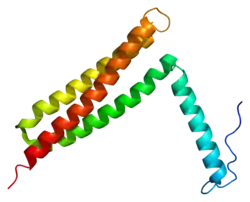
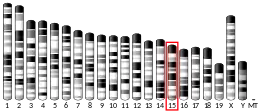

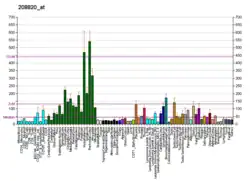
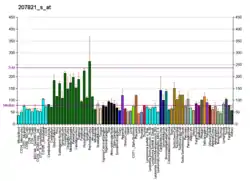
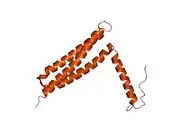
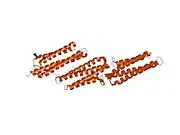
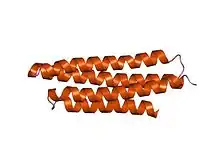

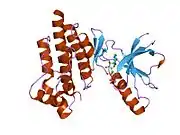
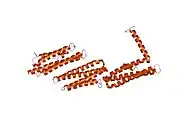
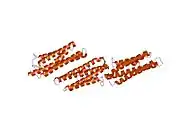
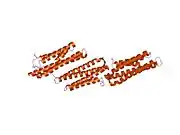
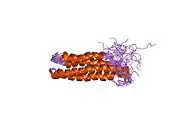
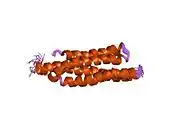
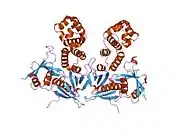
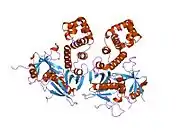
![2etm: Crystal Structure of Focal Adhesion Kinase Domain Complexed with 7H-Pyrrolo [2,3-d] pyrimidine Derivative](../I/PDB_2etm_EBI.jpg.webp)